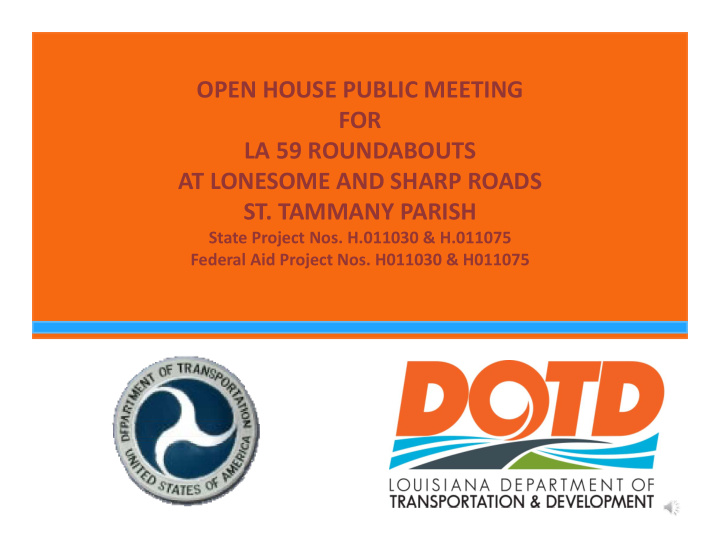



OPEN HOUSE PUBLIC MEETING FOR LA 59 ROUNDABOUTS AT LONESOME AND SHARP ROADS ST. TAMMANY PARISH State Project Nos. H.011030 & H.011075 Federal Aid Project Nos. H011030 & H011075
Project Description DOTD and FHWA propose to construct two roundabouts at the intersections of LA 59 at Lonesome and Sharp Roads. Approximately 0.32 acre of additional right-of-way is required at the Lonesome Road roundabout Approximately 1.00 acre of additional right-of-way is required at the Sharp Road roundabout. The roundabouts will replace the existing signals at the intersections of LA 59 at Lonesome and Sharp Roads.
Project Purpose and Need The purpose and need of these projects is to improve traffic flow at the intersections of LA 59 at Lonesome Road and Sharp Road.
Meeting Agenda In addition to this presentation, the following stations are available: • A Sign-in and Handout Station • An Exhibit Station to review layouts of the proposed roundabout and ask questions to project staff • A Right-of-Way Station to discuss property concerns with DOTD Real Estate Section personnel • A Comment Station for giving written and/or verbal comments (Written comments postmarked within 10 calendar days of meeting will also be included in the transcript) Project team members are available to assist you and receive your comments.
Project Location
What is a Roundabout? • Roundabouts are one-way, circular intersections designed to improve safety and efficiency for motorists, bicyclists, and pedestrians. • In a roundabout, traffic flows through a center island counterclockwise. • A roundabout redirects some of the conflicting traffic, such as left turns, which cause crashes at traditional intersections. This is because drivers enter and exit the roundabout through a series of right-hand turns. Source: DOTD Roundabouts Fact Sheet
What are the advantages of Roundabouts? • A well-designed roundabout can improve safety, operations and aesthetics of an intersection. • Greater safety is achieved primarily by slower speeds and the elimination of more severe crashes. Operations are improved by smooth-flowing traffic with less stop-and-go than a signed intersection. Aesthetics are enhanced by the opportunity for more landscaping and less pavement. Source: DOTD Roundabouts Fact Sheet
What do statistics from FHWA say about Roundabouts? • Roundabouts save lives • Reduce fatalities by up to 90% • Reduce injury crashes by up to 76% • Reduce pedestrian crashes by up to 30% to 40% • Create up to 75% fewer conflict points than a four-way intersection. Conflict points are any point where the paths of two through or turning vehicles diverge, merge, or cross. Source: DOTD Roundabouts Fact Sheet
What do statistics from FHWA say about Roundabouts? • Roundabouts save money • Reduce road electricity and maintenance costs by an average of $5,000/year. • Eliminate the costs to install and repair signal equipment • Provide a 25-year service life when compared to the ten-year service life of signal equipment. Source: DOTD Roundabouts Fact Sheet
What do statistics from FHWA say about Roundabouts? • Roundabouts provide environmental benefits • Reduce vehicle delay and the number and duration of stops compared with signalized intersections, thus decreasing fuel consumption and carbon emissions. Fewer stops and hard accelerations mean less time idling. Source: DOTD Roundabouts Fact Sheet
What are the general principles of using a Roundabout? • Think of roundabouts as a series of “T” intersections, where entering vehicles yield to one-way traffic coming from the left. A driver approaching a roundabout must slow down, stop or yield to traffic already in the roundabout, and yield to pedestrians in the crosswalk. • Then, it’s a simple matter of making a right-hand turn onto a one-way street. • Once in the roundabout, the driver proceeds around the central island, then takes the necessary right-hand turn to exit. Source: DOTD Roundabouts Fact Sheet
Can roundabouts accommodate larger vehicles? Yes. Roundabouts are designed to accommodate vehicles with a • large turning radius such as buses, fire trucks and eighteen wheelers. Roundabouts provide an • area between the circulatory roadway and the central island, known as a truck apron, over which the rear wheels of these vehicles can safely track. Source: DOTD Roundabouts Fact Sheet
LA 59 Roundabouts Typical Finished Sections
Real Estate and Right-of-Way Concerns Representatives of the DOTD Real Estate Section have a station here tonight, and they are available to answer any questions pertaining to the project site’s Right-of-Way. The DOTD Brochure explaining Acquisition of Right-of-Way is available tonight at that table or can be obtained later from: LADOTD District 62 Real Estate Office 685 North Morrison Hammond, LA 70401 (985) 375-0250 We suggest you read the available brochure carefully. If you have any questions regarding your individual situation, consult with the agent present tonight, or contact the District 62 Real Estate Office.
How Can You Help? 1. Sign-in tonight and review all materials. 2. Speak with a team member about your property location and concerns. 3. Provide us with your written or recorded comment.
This is the end of the Presentation. Thank you for your time. Please visit the remaining stations to view the exhibits and provide comments.
The presentation will begin shortly.
Recommend
More recommend